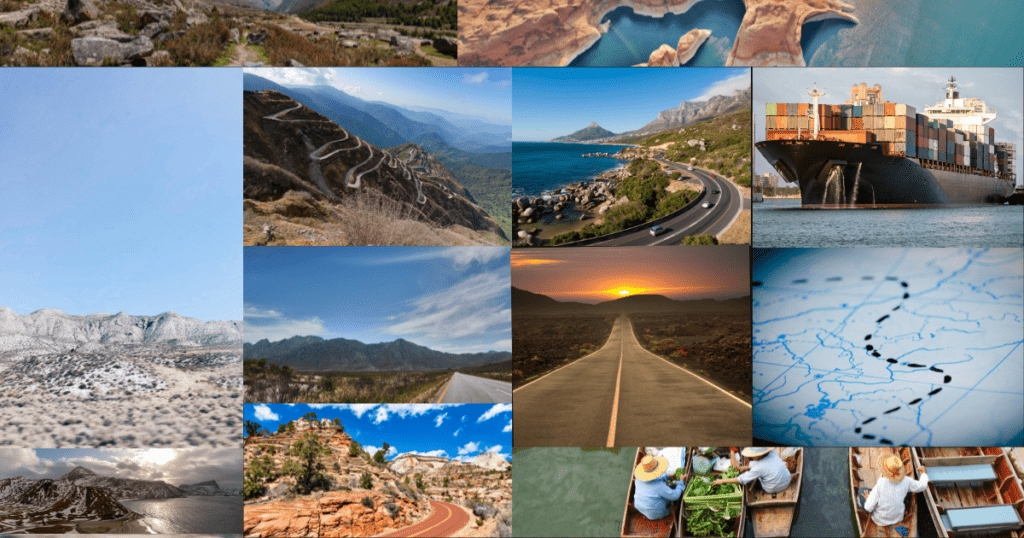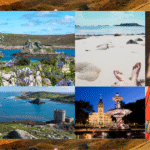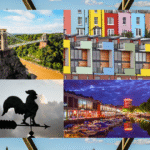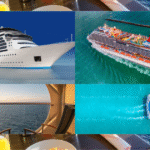Table of Contents
Introduction:
Road journey via scenic gateways is always captivating as you can mark many significant changes while cruising from one place to another. A road trip offers a long voyage towards the gateway of endless frontiers through time and ample space as we traverse along a long list of legendary milestones that might be full of excitement and an uncountable list of discoveries by offering an awe-inspiring effect in every arch.
A variety of road trips can unravel its rich history. At the same time, you can savor modern-day adventures on ancient routes, which impress with their fast progress and developments to match the business needs and demands as expected by the changing generations with the glimpses of surprises and toughness in them.
Road voyages are not only extravagant adventure opportunities under the roof of the blue sky but also a medium for a series of trade exchanges beyond boundaries that include numerous exchanges of goods by strengthening cross-border relations between the countries. Road journeys offer a smooth commute as you can relax in many frontiers by resting in suited accommodations whenever you feel it tiring and want to doze for a while by commencing another new day full of energy.
By embarking on a road trip, you might also get an opportunity to savor contemporary road odysseys by witnessing bustling marketplaces and remote desert landscapes, and most importantly, to foster cultural exchanges by talking to people who speak different languages but convey their messages of togetherness and brotherhood that you can carry with you forever while roaming freely to dissimilar destinations.
Sea, air, and road—these three roots are unanimously the only three mediums of business and adventurous journeys, and the trip via road remains the most ancient of expeditions, where fun remains unlicensed with some unbelievable memories, back at your kitty, by overshadowing the sea and air expeditions.
From the Silk Trade Routes, Gold Roads, and Maritime Silk Road, along with some breathtaking adventure routes to go with, the journey towards the vast landscape of endless beauty via road can be an infinite affair that cuddles you under the beckons with tales of cultural exchange, eye-catching events of yesteryear creativity that reflect heavily on modern civilization, unimaginable innovations, and an ocean load of discoveries that will make you think that you should meet with such an unprecedented journey in every step of life again and again.
We will discuss a series of road trips offered via different routes worldwide, waiting to surprise you with every stroke of their turn.
The Silk Route:
When it comes to worldwide business, the Silk Route is the primary choice because it offers a broader platform for trade exchange with the help of its myriad interconnected routes that touch beyond borders.
Silk routes are a significant medium to expand, e.g., cross-border cultural exchange, ideas, and technology, as people of all ages can move seamlessly from one destination to another and remain interconnected by traveling, using the most effective form of communication that comes in the form of the Silk Route. T
he adventure of traveling via the Silk Route can begin a new dimension to your road voyage, as highly orchestrated architecture, breathtaking scenery, and the opportunity to handshake with a diverse blend of cultures by fostering your inner feelings and emotions can only be possible with the practice of long-term trade that is happening between countries and continuing for so many years via the Silk Route.
Odyssey via the Silk Route can be an extramarital affair, as it opens the gateway to witnessing the ancient network of trade routes that connect East and West. As you embark on a journey towards the iconic Silk Route, follow in the footsteps of professional merchants and explore many frontiers by tracing the path of silk, spices, and other precious commodities from China to the Mediterranean, which significantly contributes to the global economy.
Once known as the Silk Routes, these routes are now the significant gateway for connecting Europe and Asia by highways that not only connect people but also do trade exchanges. Old Silk Routes have become tourist attractions and belong to China, contributing to the Chinese economy. Though the Silk Route is a significant economic corridor, it also offers adventure opportunities to enthusiasts seeking trekking and hiking.
You can trek through the gateways of mountains and have the chance to see a dense collection of flora and fauna while crossing unique landmarks on expeditions via the Silk Route. The action of the Silk Route is significant as it plays a vital role in fostering business communication between Asian and European countries by exchanging the most valuable goods, especially when it comes to spices, where exports and imports happen very frequently.
Key Takeaways:
Cultural Exchange and Diversity
The Silk Route Odyssey showcases the rich cultural heritage of the ancient civilizations that flourished along the route, highlighting the significance of cultural exchange, diversity, and significant tolerance that contributed to shaping human history.
Resilience and Adaptation
The Silk Route’s history is a testament to the resilience and adaptability of traders, travelers, and communities who braved and combated harsh climates, treacherous terrain, and unpredictable weather circumstances that connected the bridge of East and West.
Economic Empowerment Through Trade
The Silk Route’s impact on global trade and commerce is undeniable. It demonstrates how economic empowerment has been achieved through the corridors of exchange of goods, ideas, and innovations.
Environmental Awareness and Sustainability
The Silk Route’s fragile ecosystems and natural wonders, which include the Pamir Mountains and the Taklamakan Desert, are significant highlights that promote the importance of environmental awareness, sustainability, and responsible travel practices.
The Power of Human Connection
The Silk Route’s enduring legacy remains a reminder of the transformative power of human connection, collaboration, and mutual understanding that should inspire us to build effective bridges between cultures, communities, and nations.
The Spice Route:
Like the Silk Route, the Spice Route is effectively used for business communications. Delve into the tantalizing world of spices at the gateways of the Spice Road, which is a pivotal medium of trade, linking Asia and Europe seamlessly.
The difference between the Silk Route and the Spice Route is that the Silk Route offers vast landscapes of land stretched up to seven hundred kilometers that include deserts, mountains, vertical slopes of Central Asia joining China, and other significant business hubs of Europe that include Rome, Egypt, and Babylon.
The Spice Route is a route connected via a series of sea network routes by joining the East and West, spanning up to the west coast of Japan, the Islands of Indonesia, and India to the Middle East, and from the Middle East to across the Mediterranean and Europe region. From the aromatic bazaar bazaars of Istanbul to the lush spice gardens of Kerala, you can experience the vibrant flavors and aromas that have shaped cuisines and cultures throughout the century.
The Spice Roads, also known as maritime routes, were officially accepted around three thousand BCE, i.e., almost two thousand years before the Silk Route was unidentified. The Spice Route was effectively the significant gateway for transporting a variety of spices such as cinnamon, ginger, cloves, pepper, etc. Spice routes were one of the most effective mediums of expensive trade communication because they overtook some of the load from the Silk Route by splitting trade networks into different routes for smooth transitions and effective business growth.
All routes have historical significance, and with the help of the classical spice roads, cross-border trade has been strengthening, and communication has been smooth, irrespective of the country’s complicated geographical establishment. We can savor many trading places by venturing from the spice islands of Maluku in Indonesia and then moving further to Malaysia, Myanmar, Sri Lanka, and India while seamlessly floating via these ancient trade routes.
Embark on an expedition to Kerala and witness how their tourism is ambitiously working with other countries, ready to delight the traveler with its new project offerings by gifting a whole new world of travel with the help of the two-thousand-year Spice Road. The Spice Route starts in the traditional city of Kerala and almost spreads to thirty countries worldwide, where Muziris, near Kochi, remains the starting point.
UNESCO has approved new projects for the Spice Route to maximize trade among the countries. Countries like the Netherlands, Portugal, China, Britain, Iraq, Afghanistan, Indonesia, and Iran have extended their support. It is evident that with the help of new establishments, a brand new world of travel, trade, and opportunities will open up by connecting the East and West seamlessly.
So, kick-start your new expeditions by sailing through the world of spices and savoring some breathtakingly renovated museums, ports, and heritage structures that narrate the historical myths of the spice route from ancient times to the present.
Key Takeaways:
Globalization and Cultural Exchange
The Spice Route Odyssey highlights the ancient origins of globalization, showcasing how the exchange of spices, ideas, and cultures between East and West shaped human history and paved the broader gateway for modern globalization.
Economic Empowerment through Trade and Innovation
The Spice Route’s impact on global trade and commerce demonstrates how economic empowerment can be achieved through innovation, entrepreneurship, and strategic trade agreements that hugely inspire modern businesses and economies.
Dynamics that teaches the club about Resilience and Adaptation in the Face of Adversity
The Spice Route’s history is marked by challenges, setbacks, and many climatic conflicts, yet traders, sailors, and explorers are capable enough to adapt accordingly to changing circumstances and forge vivid new paths while offering valuable lessons about resilience and adaptability.
The Power of Exploration and Discovery
The Spice Route Odyssey celebrates the spirit of exploration and discovery that drove ancient mariners, traders, and explorers to venture into an unknown landscape by expanding horizons, pushing beyond boundaries, and inspiring new-aged modern-day innovators and entrepreneurs.
Legacy of Sustainable Trade Practices
The Spice Route’s history offers valuable lessons by indicating sustainable trade practices, highlighting the importance of responsible sourcing, fair trade, and environmental stewardship while encouraging modern businesses and consumers to adopt similar methods and achieve great success towards sustainable and equitable practices.
The Tea Horse Route:
Almost sixty years ago, when communication was difficult, people used the Tea Horse Road to travel via foot or hoof. The Tea Horse Road was the only route considered for trade and commerce connecting the main link between China and Tibet.
A journey along the ancient Tea Horse Road can be exciting. This historic trade route stretched from the tea-growing regions of China to the Himalayan Mountain ranges, Burma, and beyond. Discover the enduring legacy of tea cultures as you traverse from one frontier to another. From rutted mountain passes to the beaten paths of remote communities, an expedition via the Tea Route can offer you a brand-new experience with awe-inspiring effects in every arch.
The Tea Horse Road was a major trade route linking Yunnan city to Tibet and to Central China via Sichuan Province, so all significant tea trade has happened via networks that spread across China and Asia while originating from the tea distribution center on the south-west of Yunnan province of China during the ancient dynasty of Ming and Qing.
Pu’er City was the distribution center of the famed tea brand Pu’er. As Pu’er tea slowly occupied the market with its popularity, the place also became world-famous for its tea. The Tea Horse Road mainly connects Asian provinces, and a large quantity of tea has been exported to the Siberian region from China to Europe.
Explore the iconic Hengduan mountain range and the Qinghai-Tibetan Plateaus, through which tea passes by Horse Canvas Road, an area with abundant biodiversity and orthodox topography that can offer you sensational experiences. Savor the memorable expeditions towards the ancient Tea Horse Road of Yunnan Province, China, by avoiding monsoon seasons and witnessing a new world wonder in awe. Climb the mountains to discover the trace root of the tea, meet local farmers, exchange religious harmony, and spread the message of togetherness among those seeking better lives while combating their daily challenges.
Explore the thirteen-thousand-foot tunnel near Shangri-La and avoid riding motorcycles, as you might suffer from height phobia.
Tea Horse Road remains the medium of tea transportation globally, but, at the same time, apart from trade, savor brand new hospitality in a surprise invitation for a cup of tea over a conversation with someone, beginning a new chapter of friendships while camping around those green landscapes of the Tea Horse Road sights in the ancient city of Yunnan and experiencing the beauty of diversity and development going on simultaneously and seamlessly.
Key Takeaways:
Ancient Globalization and Cultural Exchange
The Tea Horse Route legacy highlights the significance and essence of ancient networks, trade, and cultural exchange between China, India, and Tibet by showcasing the unique blend of complexities and diversified globalization practices that propelled the beauty of cultural exchange and contributed to shaping human history.
Resilience and Adaptation in Harsh Environments
The Tea Horse Route’s history is marked by the incredible resilience and adaptability of traders, monks, and travelers who bravely combat the treacherous Himalayan terrain, extreme weather conditions, adversity, and banditry to exchange tea, horses, and many thoughtful ideas among them.
The Significance of the Tea Horse Route in Shaping Global Trade
The Tea Horse Route Odyssey underlines the essence, importance, and pivotal role of tea estates decisive in shaping global trade patterns, economies, and cultures by highlighting the intricate relationships between trade, culture, and politics.
The Power of Spiritual and Cultural Exchange
The Tea Horse Route’s history is intertwined with the widespread practice of Buddhism, Tantrism, and other spiritual traditions, demonstrating the profound impact of spiritual and cultural exchange on orthodox human societies and individual lives.
Lessons in Sustainable Trade and Environmental Stewardship
The Tea Horse Route Odyssey offers valuable lessons and learning points on sustainable trade practices, environmental stewardship, and responsible resource management while encouraging modern businesses, entrepreneurs, policymakers, and strong individuals to adopt more sustainable and equitable practices by stepping into the shoes of the Tea Horse Route learning tutorial.
The Incense Route:
The Incense Route is famed to be the ancient trade route of significant land and sea trading that flawlessly links the Mediterranean across the Levant and Egypt via northeastern Africa, Arabia, India, and beyond. Explore the mystical allure of the Incense Route, which not only links ancient civilizations from Egypt to India and beyond by supplying some exotic foreign goods but also has a mission to interconnect the different parts of the world.
The Incense Route is not only the medium of trade exchange of physical products but also an opportunity to do handshakes of cultures, religions, and languages, which was made possible by the mystery of this ancient trade route. Immerse yourself in the scents and spirituality of incense as you cross many frontiers by discovering the secrets of the ancient trade.
The famous city of Gaza is the last hub of the Incense Route of Trading, which connects the ports in the Mediterranean to far east China. South Arabian merchants maximized the Incense Route to transport frankincense (an aromatic gum), spices, gold, and textiles; all sources originated in Africa, India, and the Far East of China. Embark on stunning expeditions towards the Incense Route and savor unlimited agricultural systems.
Wandering the Incense Route with courage in the Negev Desert, famed for its hostile desert environment that has flourished for the last five centuries, explore the desert adventure and settle down in Tayma, Saudi Arabia, for a while, a lush maroon oasis that promotes ancient Arabian history and describes ancient civilization settlements in Saudi Arabia.
The iconic desert has been relaxing at the nose of The Incense Route, where you can halt and enjoy the caravans crossing Arabia and partner oasis AIUIA. Witness the three-thousand-year-old iron-aged temple of Salm, which surprisingly overlooks vast maroon landscapes due to its age-old beauty.
Walk past BirHaddaj, a popular tourist place famed as a moneyed city of water wells; Souq AI Najm, a three-hundred-year-old historic street where astonishing homes used as shops for business; and Qasr Ibn Rumman, The Palace Guest House, offers an impressive live show by narrating the true insight of Qasr Ibn Rumman, a castle that has a one-thousand-seven-hundred-year-long history attached to it.
Key Takeaways:
Ancient Global Trade Networks and Cultural Exchange
The Incense Route Odyssey provokes the intricate or tangled networks of ancient global trade by showcasing the exchange of incense, spices, and precious commodities between the East and the West while highlighting the profound impact of cultural exchange and its implications on human societies.
The Significance of Incense in Ancient Cultures
The Incense Route’s history underlines the pivotal role of incense and its impact on ancient cultures, from its use in spiritual rituals and ceremonies to its value-added luxury commodity products while exhibiting complex relationships and substantial influences in galvanizing trade, culture, and spirituality.
The art of resilience and adaptation to negate adversity
The Incense Route’s history is nothing short of substantial challenges, setbacks, and conflicts. Traders, sailors, and explorers prevailed and were ready to adapt to changing circumstances by discovering new trading paths and learning valuable lessons of resilience from experience, adaptability, and undeniable determination.
The Power of Luxury Commodities in Shaping Global Trade
The Incense Route Odyssey highlights the significance of luxury commodities, such as incense, spices, and precious gemstones, and their pivotal impact on global trade patterns, economies, and cultures by flawlessly demonstrating the complex relationships between trade, luxury, and power.
Lessons in Sustainable Trade Practices and Environmental Stewardship
The Incense Route Odyssey allows you to learn valuable lessons in sustainable trade practices, environmental stewardship, and responsible resource management that encourage modern businesses, policymakers, and individuals to adopt more sustainable and equitable practices by following the guidelines of ancient trade route practices by balancing economic growth with environmental protection in parallel.
The Amber Road:
Like the Incense Road, the Amber Road is also an ancient trade route that connects the Baltic Sea with the Adriatic Sea and the significant medium for transferring Amber (a hard yellowish to brownish transparent resin obtained in the form of gum from trees) from the coastal areas of the North Sea, the Baltic Sea, and the Mediterranean.
Amber Road is significant as this is the only route for lucrative trade communication connecting the Baltic and the Mediterranean Sea. The highlight of the Amber Route is the Roman military installation, established to protect merchants and traders from Germanic invaders and raids. Amber is not the only substance traded through this sea route; other goods such as animal skins, furs, honey, and wax were also part of the trade process.
As a part of the give-and-take policy, merchants would buy Roman glass, gold, brass, and other metal substances imported from the Mediterranean region. Let’s journey through the dense forests and picturesque landscapes as you trace the path of Amber, a precious gemstone revered for its beauty and mystical properties.
Amber Route is attached to many interconnected roads worldwide. E.g., countries like Germany (which connects the Baltic Sea and the North Sea), Poland (from the Baltic coastline to the coast of the Adriatic), the Netherlands (connected to the North Sea), Switzerland (pointing to the number of alpine roads), Belgium, Mongolia (connected to Eastern Europe), Southern France, and Spain (trading routes connected to the Mediterranean Sea). Explore a wide range of adventures via the Amber Route, which starts in Warsaw, Poland, and ends in Tallinn.
Savor the expeditions via the Amber Route by traveling from Warsaw to the Baltic States, Poland, and some exciting states of Europe with accommodations included. You can book your itinerary with a renowned travel agent for a seamless expedition experience. Witness the famous routes from Castle Square to Lazienki Park and Palace, the summer residence of the last king of Poland, and be part of the astounding Polish hospitality.
Take a halt and watch the Palace of Science and Culture, the Saxon Gardens, the Tomb of the Soldier, monuments of national heroes at Warsaw, and Barbican, and complete a walking tour of the ancient town of Poland. Drive past Polish countryside, Vilnius, Riga, and Tallinn by taking a walking tour of Tallinn’s upper and lower town, visit the Alexander Nevsky Cathedral and savor the fourteenth-century Gothic town hall.
From the Baltic Sea, we now switch to the Adriatic Sea, which is the long, stretched trade route that includes territories of the Czech Republic and Slovakia and ends at Gdansk while floating seamlessly in many destinations by understanding the significance of trade happening via the Amber Route. The Roman city of Aquileia is the starting point of the Amber Route.
Visit Gdansk and walk past the main street of its old town, where you can discover countless little shops with Amber products while enjoying the masterful creations and their allure and craftsmanship. Though many of the Amber routes are closed now, cycling enthusiasts can still experience the thrills of this ancient merchant route with their efforts.
A root called EV9, similar to the Amber Trail, spans from the Adriatic to the Baltic Sea. The road route begins in Pula, Croatia, passes through Italy, Austria, and the Czech Republic, and ends in Gdansk. So, traverse the Lees, then twenty-thousand-kilometer routes, and one of the shortest EuroVelo Road routes, by surprisingly meeting a merchant venturing to get the precious gold of the north.
Get ready to drive towards the destination, where adventure is waiting to cuddle you in its lap.
Key Takeaway:
The Journey of Discovery and Transformation
The story of the Amber route emphasizes the transformative power of travel. The Amber Route is a legendary trade path, not just restricted to a physical journey but also offering you an opportunity to reflect on personal growth. The Amber Route journey displays characteristics of the odyssey, a lucky chance for self-discovery, revealing the vivid style of travel, even when perilous, by offering you a platform to acquire meaningful personal transformation.
Historical Significance:
The Amber Road was a significant part of the trade networks in Europe during the Bronze Age, Iron Age, and till the Roman times.
It connected the northern and southern parts of Europe, acting as a effective link between the cultures of the Baltic and the Mediterranean.
The route contributed significantly to the cultural exchange, as goods, ideas, and technologies moved along with the amber.
Conclusion:
From ancient caravan series to modern-day expeditions, the route from Silk Road to Amber Road continues to captivate the imagination of adventurers and scholars alike. Whether you have pushed for the romance of the past or the excitement of contemporary exploration, all these routes offer a journey like no other—a voyage of discovery, connection, and cultural exchange that transcends time and borders.
Join us on this epic Road Odyssey as we trace the footsteps of traders, travelers, and explorers across seven ancient trade routes and contemporary journeys that have shaped the world we know today. Be prepared to be inspired, intrigued, and enchanted by the enduring legacy of an adventurous voyage.
FAQs
1. What are some of the most fascinating ancient trade routes to explore today, and how have they evolved?
Exploring ancient trade routes like the Silk Road, the Spice Route, the Amber Road, the Tea Horse Trade Route, and the Incense Route offers a journey through history. These routes have evolved from bustling trade pathways connecting empires to modern-day highways and cultural corridors. Today, these trade routes provide unique opportunities to experience a blend of historical landmarks, evolving landscapes, and the contemporary lifestyles of the region wherever they traverse.
2. How can travelers experience the legacy of the cultural and historical significance of ancient trade routes in the modern era?
Travelers can delve into the cultural and historical significance of these routes by visiting museums, heritage sites, and local markets on the way by engaging with local communities, participating in cultural festivals, and exploring traditional crafts and cuisines that provide a deep understanding of the legacy through these iconic routes. Utilizing guided tours and educational resources can also enrich the travel experience, offering deep insights into historical narratives and the contemporary relevance of these ancient pathways.
3. What contemporary journeys parallel these ancient trade routes, and what makes them appealing to modern travelers?
Contemporary journeys paralleling ancient trade routes, such as the modern Silk Road initiatives or the Spice Route cruises, offer an alluring mix of adventure, culture, and history. These routes are equipped with modern amenities, making travel comfortable while still providing an authentic experience in every arch and pathway. The onus lies in the opportunity to follow the footsteps of ancient traders, explore diverse landscapes, and connect with the rich cultural tapestry of each region that has evolved along these historic routes for generations.
4. What challenges did ancient traders face on these routes, and how do modern travelers experience these routes differently?
Ancient traders faced numerous challenges, E.g., harsh climates, treacherous terrains, surprise invader attacks, and long, arduous journeys. In contrast, modern travelers benefit from advanced transportation, safety measures, and well-developed infrastructure. However, to appreciate the historical context, modern travelers can opt for more authentic experiences, such as trekking or driving segments of these routes, which can provide them a glimpse into the footsteps by understanding the mental and physical toughness of ancient traders from the perspective of past kaleidoscope.
5. How can understanding the history of these trade routes enrich a traveler’s journey and perspective on global interconnectedness?
Understanding the history of these trade routes enriches a traveler’s journey by highlighting the early foundations used for global interconnectedness. These trade routes are not limited to trading purposes but are a corridor for cultural exchanges, religious ideas, and technologies across continents worldwide. Recognizing this historical interconnectedness fosters a deeper appreciation for diversity, a shared heritage of humanity that encourages a more thoughtful and immersive travel experience. This perspective can inspire travelers to reflect on the contemporary relevance of global trade and cultural exchange in today’s dynamic world.







